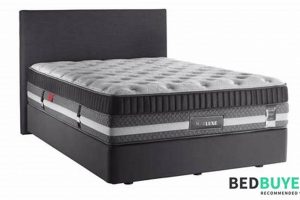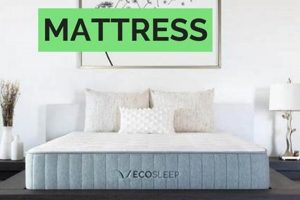The selection of a sleep surface that adequately addresses spinal alignment and minimizes pressure points is paramount for individuals seeking relief from or prevention of back discomfort. This involves assessing factors such as mattress firmness, material composition, and conforming capabilities to ensure optimal support throughout the night. A sleeping surface that fails to provide adequate sagittal support can exacerbate existing conditions and contribute to the development of musculoskeletal issues.
Proper lumbar and thoracic spinal support during sleep contributes significantly to overall musculoskeletal health. Benefits range from reduced nocturnal pain and stiffness to improved daytime posture and functionality. Historically, advancements in sleep technology have focused on developing materials and construction techniques that better distribute weight and maintain the natural curvature of the spine. This evolution has led to a wider range of options tailored to individual needs and preferences.
The subsequent sections of this discussion will delve into specific mattress types, including innerspring, memory foam, latex, and hybrid models, evaluating their respective strengths and weaknesses concerning their ability to provide adequate spinal support. Furthermore, an analysis of adjustable bases and their potential to enhance sleep posture will be presented, alongside guidance on identifying individual needs and selecting a sleep surface accordingly.
Guidance for Optimal Spinal Alignment During Sleep
The subsequent recommendations outline key considerations for selecting a sleep surface that promotes spinal health and mitigates back discomfort.
Tip 1: Evaluate Firmness Levels. Consider a firmness level that appropriately corresponds to body weight and sleep position. Lighter individuals and side sleepers often benefit from softer surfaces that allow for adequate contouring, while heavier individuals and stomach sleepers typically require firmer support to maintain spinal alignment.
Tip 2: Analyze Material Composition. Research the properties of various mattress materials. Memory foam conforms closely to the body, potentially relieving pressure points. Latex offers a more responsive and resilient feel. Innerspring systems provide traditional support with varying degrees of firmness. Hybrid mattresses combine these materials to offer a balanced approach.
Tip 3: Assess Lumbar Support. Specifically evaluate the mattress’s ability to support the lumbar region. Some mattresses incorporate zoned support systems with reinforced coils or denser foam in the center third of the mattress to prevent excessive sagging and maintain proper spinal curvature.
Tip 4: Consider Edge Support. Examine the stability of the mattress edges. Strong edge support prevents roll-off and provides a consistent sleep surface across the entire mattress, which is particularly important for individuals who sleep near the edge of the bed.
Tip 5: Research Adjustable Bases. Explore the benefits of adjustable bases. These bases allow for customization of sleep positions, potentially alleviating pressure on the spine and improving circulation. Elevation of the head and legs can also aid in reducing back pain.
Tip 6: Read Customer Reviews. Scrutinize customer reviews and ratings to gauge the experiences of other individuals with back pain. Pay close attention to comments regarding support, comfort, and durability.
Tip 7: Utilize Trial Periods. Take advantage of mattress trial periods offered by retailers. This allows for a hands-on assessment of the mattress’s suitability before committing to a purchase.
Consistent utilization of these recommendations can significantly contribute to the selection of a sleep surface that actively promotes spinal health, reduces back discomfort, and fosters restful sleep.
The upcoming section will further explore the correlation between sleep posture and spinal health, providing insights into optimizing sleep habits for improved musculoskeletal well-being.
1. Firmness adaptation
Firmness adaptation is a critical element in the selection of a sleep surface that aims to provide optimal spinal support. The appropriate level of firmness allows the mattress to conform to the body’s natural contours, promoting spinal alignment and mitigating pressure points. Failure to achieve adequate firmness adaptation can result in discomfort, pain, and compromised sleep quality.
- Body Weight Considerations
Mattress firmness requirements vary significantly depending on individual body weight. Lighter individuals typically require softer mattresses that allow for sufficient compression and contouring to support the spine. Conversely, heavier individuals necessitate firmer mattresses to prevent excessive sinking and maintain spinal alignment. Incorrect firmness selection relative to body weight can lead to misalignment and discomfort.
- Sleep Position Influence
The preferred sleep position directly impacts the optimal firmness level. Side sleepers often benefit from softer mattresses that cushion the shoulders and hips, allowing the spine to remain aligned. Back sleepers generally require a medium-firm mattress to provide adequate lumbar support. Stomach sleepers typically require a firmer mattress to prevent excessive arching of the back and maintain spinal alignment.
- Pressure Point Relief
Firmness adaptation plays a vital role in pressure point relief. A mattress that is too firm can create concentrated pressure on bony prominences, such as the hips and shoulders, leading to discomfort and potential circulatory issues. A mattress that contours effectively can distribute weight more evenly, reducing pressure on these points and promoting better blood flow. However, excessive softness can fail to provide the necessary support for healthy circulation, as well.
- Long-Term Spinal Health
Consistent use of a mattress with appropriate firmness adaptation contributes to long-term spinal health. Maintaining proper spinal alignment during sleep reduces strain on the intervertebral discs and surrounding muscles, mitigating the risk of chronic back pain and musculoskeletal issues. Investing in a mattress that addresses individual firmness needs is essential for preserving spinal integrity over time.
In conclusion, proper firmness adaptation is a cornerstone of effective spinal support during sleep. The interaction between body weight, sleep position, pressure point relief, and long-term spinal health underscores the significance of carefully selecting a mattress that conforms to individual needs and promotes optimal spinal alignment. The mattress that is too firm or too soft may result in unhealthy circulation or chronic back pain.
2. Lumbar reinforcement
Lumbar reinforcement constitutes a critical element in the design and functionality of sleep surfaces intended to provide optimal spinal support. The lumbar region of the spine, characterized by its inward curvature, requires targeted support to prevent excessive sagging and maintain proper alignment during sleep. A lack of adequate lumbar support can exacerbate existing back conditions and contribute to the development of new musculoskeletal issues.
- Targeted Support Zones
Mattress designs incorporating targeted support zones specifically address the need for increased lumbar reinforcement. These zones often feature reinforced coils, denser foam, or strategically placed support structures within the central third of the mattress. The purpose of these zones is to counteract the natural tendency of the lumbar region to sag, promoting a more neutral spinal posture throughout the night. The presence of a lumbar support zone in a mattress demonstrates a greater ability to improve back support in general.
- Prevention of Spinal Misalignment
Lumbar reinforcement plays a significant role in preventing spinal misalignment during sleep. When the lumbar region is adequately supported, the spine is less likely to deviate from its natural curvature. This, in turn, reduces stress on the intervertebral discs, muscles, and ligaments of the back. By maintaining proper alignment, lumbar reinforcement minimizes the risk of pain, stiffness, and other back-related symptoms.
- Enhancement of Sleep Posture
Adequate lumbar reinforcement directly contributes to improved sleep posture. By preventing excessive sinking of the midsection, the mattress encourages a more balanced and supported sleep position. This is particularly beneficial for individuals who sleep on their back or side, as these positions can place greater stress on the lumbar spine if not properly supported. Appropriate sleep posture can increase the quality of rest as well as reduce chronic back pain.
- Accommodation of Body Weight Distribution
Lumbar reinforcement effectively accommodates varying body weight distributions. Individuals with a higher concentration of weight in the midsection often experience greater sagging in the lumbar region. Lumbar reinforcement provides the necessary counter-support to maintain spinal alignment despite these weight variations. Different body weights demand different levels of lumbar support in order to maintain health spinal posture.
The integration of effective lumbar reinforcement mechanisms into sleep surfaces is paramount for individuals seeking to mitigate back discomfort and promote optimal spinal health. These mechanisms, ranging from targeted support zones to strategic material placement, directly address the unique needs of the lumbar region, contributing to improved sleep posture and reduced risk of musculoskeletal issues. The end result of this process is a reduction in back problems as well as general sleep improvement.
3. Pressure distribution
Effective pressure distribution is inextricably linked to optimal spinal support during sleep. Uneven distribution creates concentrated pressure points, primarily at the shoulders, hips, and knees in side sleepers, and at the sacrum and heels in back sleepers. These localized pressures impede circulation, leading to discomfort, restlessness, and potential exacerbation of musculoskeletal conditions. A sleep surface that mitigates concentrated pressure points contributes significantly to improved sleep quality and reduced back pain.
Mattress materials, such as memory foam and latex, possess inherent properties that facilitate pressure redistribution. Memory foam conforms closely to the body’s contours, distributing weight over a broader surface area and minimizing pressure peaks. Latex exhibits a more resilient and responsive feel, offering both support and pressure relief. In contrast, traditional innerspring mattresses may exhibit less effective pressure distribution due to their more rigid structure. Hybrid mattresses often combine the benefits of different materials to achieve a balanced approach to pressure relief and support. For example, a hybrid mattress incorporating a memory foam comfort layer over a supportive innerspring core aims to provide both conforming pressure relief and underlying stability. The capacity of a mattress to redistribute pressure is a determinant of both sleep quality and long-term spinal health.
In conclusion, pressure distribution is a crucial element in determining the effectiveness of a sleep surface in promoting optimal spinal support. By minimizing concentrated pressure points and facilitating even weight distribution, a mattress contributes significantly to improved sleep quality, reduced discomfort, and the prevention of musculoskeletal problems. Selection of a mattress that prioritizes pressure distribution, through appropriate material composition and construction, is essential for individuals seeking to optimize their sleep environment and protect their spinal health.
4. Spinal alignment
Maintaining optimal spinal alignment during sleep is paramount for musculoskeletal health, and the selection of a suitable sleep surface is a primary determinant in achieving this objective. A mattress that fails to provide adequate sagittal support can exacerbate existing spinal conditions and contribute to the development of new ones. The focus on achieving ideal spinal alignment is thus intrinsically linked to the concept of mattresses that are considered to provide the best support for the back.
- Natural Curvature Maintenance
The human spine possesses natural curves (cervical, thoracic, and lumbar) that must be respected during sleep. A mattress that allows these curves to either flatten excessively or become exaggerated can lead to strain on the intervertebral discs, ligaments, and muscles. A mattress designed for optimal back support will conform to the body’s shape while resisting excessive sinking, thereby preserving the natural curves. For example, a mattress with enhanced lumbar support can prevent sagging in the lower back, maintaining proper alignment for back sleepers.
- Pressure Point Reduction
Misalignment of the spine often leads to concentrated pressure points, particularly at the hips and shoulders in side sleepers. These pressure points can impede circulation and cause discomfort, leading to restless sleep. A mattress promoting spinal alignment will distribute weight more evenly, reducing pressure on these sensitive areas. Memory foam, for instance, is often cited for its ability to contour to the body and alleviate pressure points, contributing to better alignment and reduced discomfort.
- Sagittal Plane Support
Support in the sagittal plane (the imaginary plane dividing the body into left and right halves) is essential for preventing lateral bending or twisting of the spine during sleep. A mattress lacking sufficient sagittal support can allow the spine to deviate from its neutral position, leading to muscle imbalances and pain. Mattresses with a firm core and zoned support systems are designed to resist lateral movement and maintain spinal stability.
- Dynamic Adjustment Capability
Individual needs for spinal alignment vary based on body weight, sleepi
ng position, and pre-existing conditions. A mattress that offers dynamic adjustment capabilities, such as an adjustable base or customizable support layers, can accommodate these individual differences more effectively. Adjustable bases allow for elevation of the head and legs, which can reduce pressure on the spine and improve alignment. Similarly, mattresses with interchangeable support layers allow individuals to fine-tune the firmness and contouring to suit their specific needs.
The pursuit of mattresses designed for optimal spinal alignment involves a complex interplay of firmness, material properties, and construction techniques. A mattress that effectively maintains natural curvature, reduces pressure points, provides sagittal plane support, and allows for dynamic adjustment is more likely to promote healthy spinal alignment and contribute to a restful and pain-free sleep experience. Such mattresses are often considered to offer the best support for the back, aligning sleeping position with optimal spinal positioning for well-being.
5. Material composition
The efficacy of a sleep surface in providing optimal spinal support is fundamentally linked to its material composition. The selection of materials directly influences the mattress’s ability to conform to the body, distribute pressure, and maintain spinal alignment, all of which are crucial elements in mitigating back discomfort and promoting musculoskeletal health. For instance, memory foam, characterized by its viscoelastic properties, conforms closely to the body’s contours, distributing weight evenly and reducing pressure points. This characteristic makes it a frequently cited component in mattresses marketed for their back support benefits. Conversely, traditional innerspring mattresses, while offering support, often lack the conforming capabilities of foam-based materials, potentially resulting in localized pressure and spinal misalignment. The inherent properties of different materials are thus a primary determinant of a mattress’s suitability for providing back support.
The interplay of different materials within a mattress also impacts its overall performance in supporting the spine. Hybrid mattresses, which combine innerspring cores with layers of memory foam or latex, aim to balance support and pressure relief. The innerspring system provides the underlying structural support, while the foam or latex layers offer conforming comfort and pressure redistribution. The layering and density of these materials are carefully engineered to achieve a specific firmness level and support profile. For example, a hybrid mattress designed for individuals with lower back pain might incorporate a zoned support system with denser coils or foam in the lumbar region, providing targeted reinforcement to prevent sagging and maintain spinal alignment. The precise arrangement and characteristics of the constituent materials are therefore critical in optimizing the mattress’s back support capabilities.
In conclusion, the material composition of a mattress is a primary factor influencing its ability to provide optimal spinal support. Different materials possess unique properties that directly impact pressure distribution, conformity, and spinal alignment. Selecting a mattress with appropriate material combinations and construction techniques is essential for individuals seeking to alleviate back pain and promote musculoskeletal health. While material composition is a significant factor, it is important to consider other aspects, such as firmness and individual sleep preferences, to achieve a sleep surface that effectively addresses individual needs and promotes restful sleep.
6. Edge stability
Edge stability, often an overlooked attribute in mattress selection, plays a critical role in contributing to the overall support and comfort provided by a sleep surface. Particularly, it interfaces directly with how a mattress can deliver optimal back support. A mattress with compromised edge support can undermine the effectiveness of its other design features intended to promote spinal alignment and pressure relief.
- Consistent Sleep Surface
Strong edge support ensures a consistent sleep surface across the entire mattress. Weak edges can cause the perimeter of the mattress to collapse or sag, reducing the usable sleep area and creating an uneven sleeping surface. This inconsistency can force sleepers to migrate toward the center of the mattress, potentially disrupting spinal alignment and leading to discomfort. Mattresses with reinforced edges provide a stable and uniform surface, allowing sleepers to utilize the full width of the bed without compromising support.
- Ease of Entry and Exit
Solid edge support facilitates ease of entry and exit from the bed, a significant consideration for individuals with mobility issues or back pain. Weak edges can make it difficult to sit comfortably on the side of the bed, increasing the risk of falls and exacerbating existing pain conditions. A mattress with sturdy edges provides a stable platform for sitting, reducing strain on the back and joints during ingress and egress.
- Support for Edge Sleeping
Some individuals prefer or are compelled to sleep near the edge of the bed. Without adequate edge support, these sleepers may experience a sensation of rolling off the mattress, disrupting sleep and potentially leading to spinal misalignment. A mattress with enhanced edge support allows sleepers to comfortably and safely utilize the entire surface, regardless of their preferred sleeping position. A firm mattress edge increases usable sleep surface and reduces the risk of injury.
- Durability and Longevity
Enhanced edge support contributes to the overall durability and longevity of the mattress. Weak edges are prone to premature wear and tear, leading to sagging and reduced support over time. A mattress with reinforced edges is more resistant to deformation and maintains its structural integrity for a longer period. This extended lifespan translates to a more consistent and reliable sleep surface, optimizing long-term back support.
The importance of edge stability extends beyond mere comfort; it significantly impacts the ability of a mattress to provide consistent and reliable support for the back. By ensuring a uniform sleep surface, facilitating ease of movement, and contributing to overall durability, enhanced edge support complements the other features of a well-designed mattress aimed at promoting spinal alignment and alleviating back pain.
Frequently Asked Questions About Mattress Selection for Back Support
The subsequent questions and answers address common inquiries regarding the selection of mattresses designed to provide optimal back support and promote spinal health.
Question 1: What firmness level is generally recommended for individuals with back pain?
The optimal firmness level is subjective and depends on factors such as body weight, sleeping position, and specific spinal conditions. A medium-firm mattress is often recommended as a starting point, providing a balance of support and pressure relief. Individuals should prioritize a mattress that maintains spinal alignment without creating excessive pressure points.
Question 2: Are memory foam mattresses inherently better for back support than innerspring mattresses?
Neither mater
ial is inherently superior. Memory foam conforms to the body’s contours, distributing weight and reducing pressure points. Innerspring mattresses offer a more traditional support system. The ideal choice depends on individual preferences and specific needs. Hybrid mattresses, combining both materials, may provide a balanced approach.
Question 3: How does sleeping position influence the selection of a mattress for back support?
Sleeping position significantly impacts mattress selection. Side sleepers often benefit from softer mattresses that cushion the shoulders and hips. Back sleepers typically require a medium-firm mattress to support the lumbar region. Stomach sleepers generally require a firmer mattress to prevent excessive arching of the back. Selecting a mattress appropriate for the primary sleeping position is crucial for maintaining spinal alignment.
Question 4: Is it necessary to purchase an expensive mattress to obtain adequate back support?
Price is not necessarily indicative of superior back support. While higher-priced mattresses may incorporate advanced materials and construction techniques, the most important factor is whether the mattress effectively supports spinal alignment and relieves pressure points. Evaluating individual needs and comparing various models within a reasonable budget is advisable.
Question 5: How often should a mattress be replaced to ensure continued back support?
Mattress lifespan varies depending on material composition, usage, and individual weight. A general guideline suggests replacing a mattress every 7-10 years. However, visible signs of wear, such as sagging, lumps, or indentations, indicate the need for earlier replacement, regardless of age. Declining sleep quality and increased back pain are also indicators of a deteriorating mattress.
Question 6: Can an adjustable base improve back support, even with an existing mattress?
An adjustable base can potentially enhance back support by allowing for customized sleep positions. Elevating the head and legs can reduce pressure on the spine and improve circulation. However, the effectiveness of an adjustable base depends on the compatibility with the existing mattress and the individual’s specific needs. It is not a substitute for a mattress that provides adequate support in its neutral, flat position.
Careful consideration of these factors will contribute to the selection of a mattress that effectively supports spinal health and alleviates back discomfort.
The next section will provide guidelines on assessing personal sleep needs in order to make informed decisions regarding mattress selection.
Conclusion
The preceding discussion has explored key elements contributing to the selection of sleep surfaces designed to promote spinal health. Factors such as firmness adaptation, lumbar reinforcement, pressure distribution, spinal alignment, material composition, and edge stability directly influence the efficacy of a mattress in providing optimal back support. Individual needs, including body weight, sleeping position, and pre-existing conditions, necessitate careful consideration when evaluating various mattress types and features.
The selection of a sleep surface that effectively addresses these critical factors is a significant investment in long-term musculoskeletal well-being. Future advancements in sleep technology may offer further refinements in personalized support and alignment. Individuals are encouraged to utilize the insights provided to make informed decisions, prioritizing a sleep environment conducive to sustained spinal health and restful sleep.


![Top-Rated: Choosing the Best Mattress Foundation [Guide] Organic & Natural Mattress Buyer’s Guide: Non-Toxic Sleep Solutions Top-Rated: Choosing the Best Mattress Foundation [Guide] | Organic & Natural Mattress Buyer’s Guide: Non-Toxic Sleep Solutions](https://mattressworldpa.com/wp-content/uploads/2025/07/th-7633-300x200.jpg)




![How to Find the Best Way Twin Air Mattress [Guide] Organic & Natural Mattress Buyer’s Guide: Non-Toxic Sleep Solutions How to Find the Best Way Twin Air Mattress [Guide] | Organic & Natural Mattress Buyer’s Guide: Non-Toxic Sleep Solutions](https://mattressworldpa.com/wp-content/uploads/2025/07/th-7628-300x200.jpg)